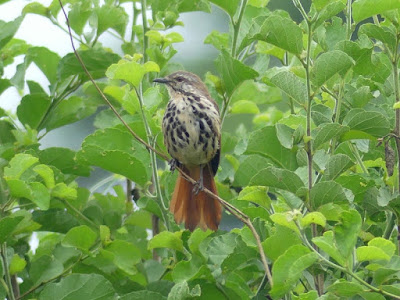Today I want to complete my introduction to the wonderful but under-appreciated Tarangire National Park in northern Tanzania which, as I explained in part 1, undeservedly seems to live in the shadow of nearby and better-advertised Serengeti and Ngorongoro Crater. If you missed the previous instalment you might like to take a peek there before reading this, as there's quite a bit of information about the park there. Today I want to focus on the birds of Tarangire, of which nearly 500 species have been recorded - but don't blanche, I shall just be offering a selection today!
This roller was just one of around 120 species that we saw in our relatively brief sojourn in the park (less than 48 hours) - and bear in mind that you can't get out of the vehicle. (See the first instalment of this blog to realise why!) Moreover, had we been there a few weeks earlier, large numbers of migrants from Europe and western Asia would also have still been present (though we'd also quite likely have got bogged and many of the fabulous mammals would have been on migration out of the park).
One of the few places where you can walk around is the extensive picnic area at the entrance gate, and you will be greeted by a range of birds as soon as you alight.
 |
| Ashy Starling Lamprotornis unicolor is another Tanzanian endemic. Africa is rich in starlings, but this is one of the least colourful. |
 |
| Red-necked Spurfowl (or Francolin) Pternistis afer is common in Tarangire, as is its close relation the Yellow-necked Spurfowl Pternistis leucoscepus (below). |
 |
| Both species are noisy, especially when displaying from a termite mound or shrub early or late in the day. Spurfowls and francolins are in the pheasant, quail, chook etc family. |
Other birds can also be seen without the assistance of a vehicle at the various lodges; here are a few impressive 'house birds'.
 |
| Lesser Striped Swallow Cecropis abyssinica; a familiar and handsome swallow of much of sub-Saharan Africa. It is happy to share its home with humans. |
 |
| African Scops Owls Otus senegalensis also have a very wide distribution. And I could not find a vantage point without that stick across its face! |
Which brings us to predatory birds and, unsurprisingly with such a richness of resources, there is a broad diversity of them. Let's start with another common owl, the little Pearl-spotted Owlet Glaucidium perlatum.
 |
| Like the South American pygmy-owls to which it is very closely related, this one has eye-spots on the back of its head to persuade bigger predators that it is watching! |
And of course there are many diurnal hunters, from small to very large.
 |
| Pygmy Falcon Polihierax semitorquatus, a tiny falcon which breeds in weaver nest chambers. In this part of the world the hosts are usually White-headed Buffalo-weavers (see above). |
 |
| A small falcon, most of her food is insects, especially termite and ant swarms in Africa. |
 |
| Immature Martial Eagle Polemaetus bellicosus. This big powerful predator takes a range of medium-sized prey, mammals, birds and reptiles (especially big monitor lizards). |
But there are other hunters of vertebrates apart from owls, falcons, hawks and eagles. It's not an easy gig being a small animal (or indeed a large one if you're down the food chain) in such a place.
 |
| Magpie Shrike Urolestes melanoleucus, along with other shrikes, are scattered in vantage points across the landscape. |
 |
| Northern White-crowned Shrikes Eurocephalus ruppelli are even more prevalent, but being smaller tend to limit their ambitions to invertebrates. |
 |
| Knob-billed (or African Comb) Ducks Sarkidiornis melanotos; males above, females below. The male's bill knob increases in size during breeding season. |
 |
| The attractive White-faced Whistling Ducks Dendrocygna viduata are found not only widely in Africa, but through most of South America as well. |
 |
| Water Thick-knees Burhinus vermiculatus. The group of mostly nocturnal foragers, superbly camouflaged, is also known as stone-curlews (in Australia, Europe and Asia). |
 |
| Double-banded Courser Rhinoptilus africanus, looking more like how the field guides portray coursers! |
 |
| Spotted Palm Thrush Cichladusa guttata; a most attractive bird and a truly superb singer and mimic. |
 | |
| Meyer's Parrot Poicephalus meyeri is in life more deeply coloured than this light shows. It is one of the 'African and New World' family of parrots, unlike the lovebird above. |
 |
| Male Red-cheeked Cordon-bleu Uraeginthus bengalus, holding down a relatively enormous grass stalk (the bird weighs no more than 10 grams) to harvest the seeds. |
By the time my next post appears I'll again be in South America, so another slightly longer hiatus between posts. But I'll be back in time for (our) spring!
NEXT POSTING THURSDAY 1 AUGUST - A CELEBRATION OF ORCHIDS!
(And remember that you can get a reminder when the next post appears by putting your email address in the Follow by Email box in the top right of this screen.
And I'd love to receive your comments - it's easy and you don't need to sign in!)
(And remember that you can get a reminder when the next post appears by putting your email address in the Follow by Email box in the top right of this screen.
And I'd love to receive your comments - it's easy and you don't need to sign in!)





















